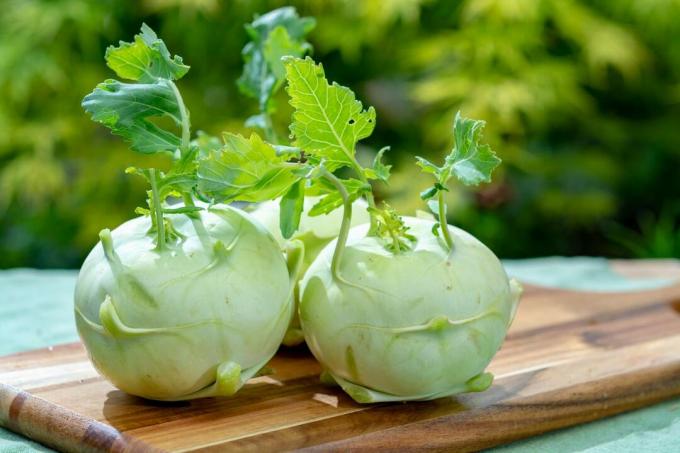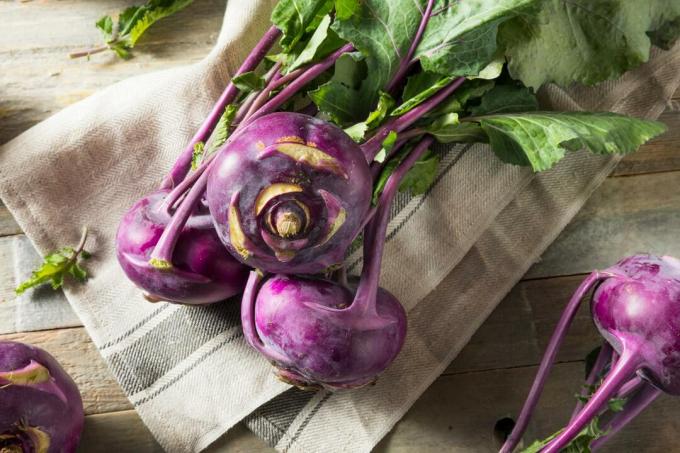Kohlrabi is a cabbage vegetable that can be successfully grown in your own garden. Here you can find out everything you need to know about planting kohlrabi.
Kohlrabi (Brassica oleracea var. gongylodes L.) is a member of the cabbage family that is very rich in vitamins and nutrients. In contrast to many other types of cabbage, the kohlrabi does not contain the flower stalks (such as B. for cauliflower & broccoli), but rather the stalk that is thickened in the lower area. The kohlrabi also differs somewhat from its colleagues in its cultivation. In this article you will find out what you should consider when planting kohlrabi and which varieties are particularly tasty!
"Contents"
-
Growing kohlrabi: location and the right time of year
- Planting kohlrabi: the right location
- Plant out the kohlrabi
- Plant kohlrabi on the balcony
-
Growing kohlrabi: Propagate yourself or buy kohlrabi plants?
- Buy kohlrabi seeds
- Buy kohlrabi plants
- Kohlrabi varieties: ‘Superschmelz’ and other kohlrabi varieties
- Harvesting kohlrabi: when is harvest time?
- Store and keep kohlrabi
Growing kohlrabi: location and the right time of year
Kohlrabi is a relatively fast-growing culture. The cultivation period is between 10 and 14 weeks. Depending on whether you want to grow your kohlrabi yourself or prefer to use seedlings from a specialist retailer, the optimal time to plant kohlrabi may be postponed.
Planting kohlrabi: the right location
Kohlrabi is a very fast-growing vegetable that does not have the highest demands on its location due to the short cultivation time. The taste of kohlrabi depends primarily on the consistency of the tubers. The faster they grow, the more tender the tuber tissue will be. In order to guarantee rapid growth, compost (and, if necessary, well-rotted manure) should be worked into the bed as early as autumn. The bed prepared in this way can then hibernate fallow and wait for the kohlrabi plants. The light conditions should be partially shaded to sunny so that the growth of the tubers is not impaired. Alternatively, you can use a primarily organic organic fertilizer with long-term effects such as ours before planting Plantura organic tomato fertilizer work into the earth. In this way you create optimal conditions for starched kohlrabi plants.
Plant out the kohlrabi
At the end of March / beginning of April the kohlrabi plants are ready to be planted. Depending on the variety, a planting distance of 25 to 50 cm should be chosen so that the plants do not compete too strongly for light and water.
Important: Plant the kohlrabi seedlings only 2 to 4 cm deep. This prevents the tuber from coming into direct contact with the ground and possibly rotting! The soil should be watered regularly during the 10 to 14 week growing season so that growth does not stagnate.
Attention: Waterlogging should be strictly avoided. Otherwise, the bulbs growing above ground tend to burst and rot!

Here is a summary of the most important steps:
- Loosen up the bed before winter, enrich it with humus and let it lie fallow.
- Seedlings in the greenhouse or on the windowsill approx. Wear for 6 weeks.
- Plant kohlrabi: 2 to 4 centimeters deep; at the end of March at the earliest; Maintain row spacing of 25 to 50 cm (depending on the vigor of the variety).
- Water regularly, but avoid waterlogging!
Plant kohlrabi on the balcony
If you don't have access to a flower bed, but have a beautiful and sunny balcony, you don't have to despair. Kohlrabi can also be grown there. However, the absolutely necessary spacing of at least 25 cm between the individual kohlrabi plants is a limiting factor. Usually the plant pots are only big enough to accommodate a kohlrabi plant.
Tip: A self-made raised bed can serve as an alternative to the plant pots. A guide to Build a raised bed yourself You will find here.

Growing kohlrabi: Propagate yourself or buy kohlrabi plants?
Buy kohlrabi seeds
Kohlrabi seeds are available from all well-stocked specialist shops and from many mail-order gardeners. A seed sachet with around 50 seeds is available for as little as 1.30 euros. First, the seeds are placed in small pots (diameter approx. 5-6 cm) or tightened on pot plates. It is important to use a loose and water-bearing planting medium (such as B. Compost). During the germination phase, kohlrabi needs temperatures around 20 ° C. These temperatures are best reached on the windowsill or in the greenhouse. After the kohlrabi has sprouted, the temperature can be lowered.
Attention: However, it should not fall below 10 ° C, otherwise tubers may not be formed! The kohlrabi should not be added to the bed before the end of March so that night frosts can be excluded.
Buy kohlrabi plants
The safest way to get healthy and strong young plants is to buy kohlrabi seedlings in specialist shops. The young pupils are often sold on multi-plates with 10 or more plants. The setting plants are also very affordable. For only two euros, you can buy a pot plate with around 10 young plants. At the time of purchase, the plants have mostly left the greenhouse phase behind and are 6 to 8 weeks old.

Kohlrabi varieties: ‘Superschmelz’ and other kohlrabi varieties
There is kohlrabi - like almost all members of the Brassicaen (Cruciferous) - in many different varieties. A main distinction is made between white and blue kohlrabi. Probably the best-known variety is 'Superschmelz', but there are many other interesting variations. We have put together a selection of the best kohlrabi varieties for your garden:

- Super melt: Well-tried white variety; no lignification, therefore very delicate; high yield; large tubers (up to 5 kg possible).
- Blaro: Purple variety; known for their fine, spicy taste; does not tend to shoot.
- Knauf's early white: Old, traditional variety; known for its good aroma; ripe very early; light green, flat tubers.
- giant: Very slow growing variety; can reach tuber weights of up to 5.5 kg; Pay attention to the harvest time, as there is a tendency to lignification.
- Azure Star: Fast growing variety; early harvest time; purple tubers.
Read more about the here Variety of kohlrabi varieties.
Harvesting kohlrabi: when is harvest time?
It is not so easy to narrow down the harvest period for kohlrabi, as it can be planted from early spring to midsummer. Rather, there are some distinctive signs to watch out for so that you can harvest your beloved kohlrabi at the right time. We have listed some tips for you:
- Rule of thumb: About 12 weeks after planting out, the kohlrabi tubers are ready for harvest (subject to varietal differences)
- Above-ground tuber is flat-round / oval
- Blue varieties take longer to ripen than white kohlrabi varieties
- Leaves are lush green
- White varieties tend to lignify more than blue ones
- Harvest the kohlrabi before the first winter frosts at the latest
- Don't wait too long: tissue becomes lignified with increasing age

Conclusion: It is better to harvest your kohlrabi a little early rather than too late. The possibly slightly lower yield is compensated for by the fine, spicy taste and better consistency!
Store and keep kohlrabi
-
Store kohlrabi in the refrigerator
Kohlrabi will keep in the refrigerator for about a week. Before doing this, you should remove the woody parts and the leaves to reduce the evaporation area. -
Freeze the kohlrabi
Kohlrabi can also be stored frozen well. Wash and portion your kohlrabi beforehand and blanch it for 2 to 3 minutes in boiling salted water. Less of the lush green is then lost when thawing. -
Reduce the kohlrabi
Before you boil down your kohlrabi, you should blanch it for a few minutes. After blanching, put the kohlrabi in mason jars. You can now fill the glasses with salted water or a delicious vegetable sauce.
Important: Whether salt water or sauce, both liquids should be boiled and cooled before pouring the glasses! This guarantees a longer shelf life. After closing the jars, they should be left again for approx. Boiled for 20 to 30 minutes.
More information about the Storing kohlrabi see this article.
